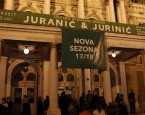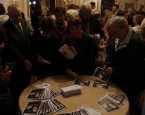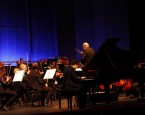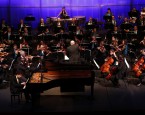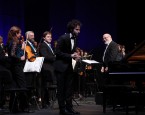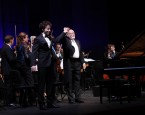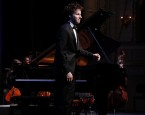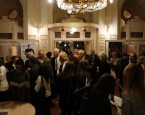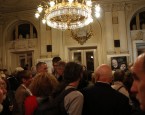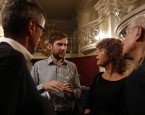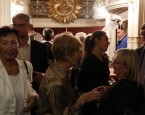
JURANIĆ & JURINIĆSeason opening 2017/2018
Programme:
I. pl. Zajc: Fiuman Rhapsody /Rapsodia fiumana
S. Prokofiev: Piano Concerto No. 2 in G minor, Op 16
I. Andantino
II. SCHERZO: Vivace
III. INTERMEZZO: Allegro moderato
IV. FINALE: Allegro tempestoso
*****
L. van Beethoven: Symphony No.7 in A major, Op. 92
I. Poco sostenuto, Vivace
II. Allegretto
III. Presto
IV. Allegro con brio
Ivan pl. Zajc (1832 – 1914) is a Croatian composer, conductor and musical pedagogue. It has not often happened in recent cultural history that an artist dominates the music of a nation for the entire four decades, as it was the case with the composer Ivan pl. Zajc. It is after him that the period of Croatian music from 1870 until 1916 was named. Zajc is not only the founder of Croatian opera as an institution but he has also enriched the art of opera in Croatia in the creative sense, as it was only one Croatian opera that had been performed until his arrival to Zagreb, namely, Love and Malice by Vatroslav Lisinski. Zajc’s opus numbers over a thousand works! Among them are operas (Mislav, Ban Leget, Nikola Šubić Zrinjski, Lizinka, Pan Tvardovski, Zlatka, The King’s Whim (Kraljev hir), The Original Sin (Prvi grijeh), The Girl from the Coast (Primorka), Galileo Galilei and Armida), operettas, numerous cantatas, songs and choral compositions, concerti and chamber music as well as works from all fields of music creation.
Maestro Zoran Juranić on Zajc’s composition to be performed tonight:
«Ivan pl. Zajc wrote the composition Rapsodia Fiumana, Op. 731 (as Quadro sinfonico in the subtitle) during his holiday in Lovran in the August of 1891, after the Rijeka Società filarmonico-drammatica had expressed the wish to devote an orchestral composition to the musicians in their birthtown. The inscription to the Rijeka Society was written on the cover of the score: «Alla lodevolissima Direzione e Società Filarmonico-drammatica in Fiume l’autore in segno di sentita stima dedica la presente Rapsodia fiumana…” (To the highly esteemed Philharmonic and Dramatic Direction and Society in Fiume, in sign of heartfelt respect, the author dedicates this Rapsodia Fiumana..»)
True to his rich melodic invention, Zajc wrote an unpretentious, airy and likeable piece, which, according to models and inspiration, is closer to the works from his Vienna, operatic period, than operas and compositions created for the Zagreb stages and concerts. It would be interesting to research whether the simple, almost kitschy melody in the central part is a quote of a city melody from Zajc’s youth in Rijeka.”
Sergey Sergeyevich Prokofiev (1891 – 1953) one of the most prolific and significant Russian composers of the 20th century, a conductor and a pianist, composed seven symphonies, six piano concertos, eleven piano sonatas, fourteen operas (the most famous being The Love for Three Oranges, War and Peace, The Gambler, etc.), nine ballets (Romeo and Juliet, Cinderella, etc.), orchestral works, songs, choral compositions, film music (e.g. for Ivan the Terrible and Alexander Nevsky by the director Sergey Eisenstein), also known for the symphonic children’s tale Peter and the Wolf, for which he wrote music and the text. Although he was a markedly productive composer, his music, just as Shostakovich’s, bore the brunt of the Stalinist regime (being both prized and degraded) so that he spent the last years of his life in failing health and financial insecurity.
Prokofiev began to assert his musical personality by his two piano concertos, distancing himself from the prevailing tastes. Prokofiev’s First Piano Concerto, completed in 1912, helped to establish his reputation as an enfant terrible, according to what was discussed by the shocked professors and critics. However, he received the Rubinstein Prize for this Concert.
The Second Piano Concerto Prokofiev composed during the 1912 and 1913, in an attempt to compose a work of greater depth, although it requires even greater virtuosity. The composer played the solo part of his Second Piano Concerto in G Minor, Op. 16 at its premiere in September 1913, in the town of Pavlovsk, near Saint Petersburg. It was a concert everyone talked about, some expressing loud enthusiasm and praise, others hurrying to the exit while cursing the futuristic music, sorry because they had come to enjoy while they had to listen to what drove them mad. It was a year of numerous “scandalous” premieres (e.g. only four months after Stravinsky’s Rite of Spring).
Prokofiev dedicated the Second Piano Concerto to his close friend and pianist Maximilian Schmidt, who had committed suicide that year. During the Russian Revolution, the original manuscript score of the Second Concerto was destroyed in fire in Prokofiev’s St. Petersburg apartment. As his friends informed him, the new “tenants” used it as fuel to cook an omelet.
The second version of the Second Concerto was written during his stay in Paris in 1923, when Prokofiev decided to reconstruct the score from memory. He played the solo part of his favourite work again at its premiere in Paris in 1924.
The Piano Concerto No. 2 in G minor, Op. 16 is one of the most technically demanding piano pieces in the whole of the piano literature.
Ludwig van Beethoven (1770 – 1827) is a German composer and piano virtuoso that belongs to the very top of the European classical music, having created an extensive musical opus and laid the foundations for the Romantic expression. He composed in several musical genres, i.e., piano sonatas (32), chamber music (16 string quartets), symphonies (9), overtures and other orchestral works, soloist compositions, compositions for wind instruments, various works for piano (sonatas, variations, etc.), masses, operas, ballet and stage music, cantatas, songs, arias, choral compositions as well as canons and interpretations of popular songs.
Beethoven started composing the Seventh Symphony in the silence and natural beauty of a Hungarian spa in 1811. The Symphony was premiered at a charity concert for Austrian and Bavarian soldiers wounded in the Battle of Hanau a few months earlier. The Vienna audience, depressed after the Napoleon’s invasion of Vienna in 1805 and 1809, also looking forward to the victory over him, embraced the energy and beauty of the symphony.
The crowd stood up thanking for the joyful symphony of the victorious rhythm.
Although some heard this work as a proof that the composer had lost his sanity, this symphony is one of his most optimistic works, having also captivated Richard Wagner who considered the Seventh Symphony the Apotheosis of the Dance itself. Its most popular, the second movement, has been fascinating ever since its premiere and has inspired many artists.
It is interesting to note that composer’s brother found a love letter addressed to the Immortal Beloved, not long after Beethoven’s death. The words of this letter were written parallel with the notes of the Seventh Symphony. This is the reason why it is often concluded that they are connected by the same energy and same positive thought, that the exuberant, celebratory symphony is a musical translation of an actual happiness.


